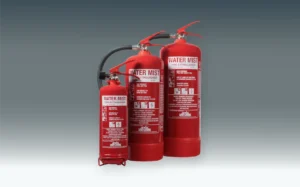
Wet Chemical Fire Extinguishers
are designed for safely extinguishing cooking oil and fat fires, commonly found in commercial kitchens and the food industry.
Best for Classes of Fire: A, B
Home / Fire Fighting Equipment / Fire Extinguishers / Class D Powder Fire Extinguishers
Class D extinguishers are for covering a unique risk which is burning metals, and this is something which is becoming more frequently amongst us with the vast amount of battery-operated equipment around us and the huge amounts of lithium.:

There are two types of the class D fire extinguisher, one for lithium and one for other metals such as magnesium and potassium, etc.
The extinguisher medium is a powder, which is applied using a low-velocity lance, which ensures a powder comes out as a gentle flow rather than a fast jet reducing the risk of burning particles being spread around the area.
They are a lot more expensive than conventional extinguishers, both in terms of purchasing and refilling. But where the risk is there, that’s the only choice. That’s the only application that can be installed.
Contact us now to learn more about Class D Powder Fire Extinguishers and how they can be an essential part of your fire safety plan.
Class D fire extinguishers are suitable for fires involving combustible metals. These metals are typically found in industrial settings, laboratories, and manufacturing facilities.
Metals like magnesium, titanium, sodium, potassium, and certain alloys are considered combustible and require the use of Class D fire extinguishers.
Class D fire extinguishers work by smothering the fire and preventing the metal from reacting with oxygen. They often contain dry powder agents, such as sodium chloride or powdered graphite, which create a barrier to inhibit the chemical reactions that sustain the fire.
No, Class D fire extinguishers are specifically designed for combustible metal fires. Using them on other types of fires, such as those involving flammable liquids or electrical equipment, is not recommended and may be ineffective or even dangerous.
Class D fire extinguishers are commonly found in industrial facilities, laboratories, and locations where combustible metals are present. This includes places where metalworking, machining, or other processes involving combustible metals take place.
The general procedure for using a Class D fire extinguisher is similar to other types. Pull the pin, aim the nozzle at the base of the fire, squeeze the handle to discharge the extinguishing agent, and sweep the nozzle from side to side. However, always follow the specific instructions provided on the extinguisher.
Yes, like other fire extinguishers, Class D extinguishers require regular maintenance. This includes visual inspections, pressure checks, and periodic professional inspections to ensure they are in good working condition.
Generally, Class D fire extinguishers are not recommended for home use. Home fires typically involve different materials, and the use of a Class D extinguisher may not be effective or safe. It’s advisable to use a multi-purpose ABC fire extinguisher for home fire protection.
Don’t hesitate to reach out to us, or you can easily fill out the form below. We’re here to assist you.


are designed for safely extinguishing cooking oil and fat fires, commonly found in commercial kitchens and the food industry.

work on various fires, including liquids and electrical equipment, by emitting a cooling mist to suppress and contain the fire.

are used to put out fires in wood, paper, and similar materials. They work by cooling down the fire and
